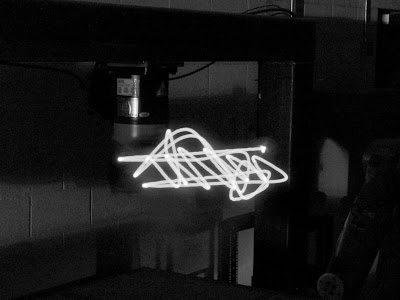Project Description |
It's very exciting that we are going to play with robots! This project requires us to use robot arms (KUKA) to accomplish a series of tasks including 3D locating, maze running and light drawing. In the beginning, all of us need to be trained for several days and get familiar with KUKA|Prc which is a plug-in of Grasshopper in Rhino, and then, play with it! In this project we need to use robot rams to accomplish the light drawings in dark. The geometry may be a new design or from the previous models (we can use digitizer to scan it), and use KUKA|Prc to generate the drawing paths for KUKA.
Robot Light Drawing, Jeff Boyer & T.C. Kurt Hong, Summer 2015
KUKA Robot Arms |
It is very lucky for us that UM's policy is to let students contact new technologies without being afraid of breaking them (of course, need to be trained in advance). UM gives us a lot of freedom to play with those big machines and thus we can gradually get comfortable with them. While we were trying those robots, trials and errors helped us figure out how to control the robots. Furthermore, sometimes we can figure out how to use them in a better way (our instructors and TA are always telling us that we don't have to follow the settings which are defined by others because we may find a better one). We appreciate it, and indeed some beautiful works hence are created because some particular settings and methods are adopted.
The test movement for Robot Drawings, Jeff Boyer & T.C. Kurt Hong, Summer 2015
Tools, Limitations and Opportunities |
Making is based on what tools and materials we use. Therefore, "tooling" is an important issue in design. After the test run of the robots, we had some discussion about making, designing and thinking. Actually these three things should be one thing. Making is designing, and meanwhile making is also thinking. Hence, tool's limitations and logic are sometimes the boundaries and opportunities of thinking and designing. For example, if the architect is required to use only a hammer and nails to build up a house but other tools such as saws, knives or rulers. The house may be very odd but unique. The identity is from the tool (the hammer), and the design/thinking/making process is constrained by the hammer and the gestures of the architect while she/he is using it. Based on the same reason, the robots can also generate the unique works which can be made only by the robots. In Adam Holder's lecture, I asked Adam a question about the qualities of the digital tool (the qualities that only can be achieved by digital tools). Adam gave us a good example to this question, 3D movies/animates. 3D movies/animates can offer audiences spectacular experience and this experience can only be transmitted by digital technologies. Back to the tools, the computer, projector and the 3D glasses are the tools which can offer the unique experience for people. But, the tools are also define the limitations of the works.
Movement types in KUKA|Prc
The original geometry, Jeff Boyer & T.C. Kurt Hong, Summer 2015
Robot Drawings |
In this summer, we have many projects and those projects are telling us the limitations and the opportunities of the tools. Especially in this project, we use KUKA|Prc to draw the geometry we design. There are 4 different movement types in KUKA|Prc, P2P, Linear, Spline and Circular movement, each movement has its own characteristics. First step, we sample the geometry and get a few points. Then we use different algorithms to generate the respective drawing paths of robot arm based on those points. The pictures below physically shows the difference among those movements.
P2P Movement, Jeff Boyer & T.C. Kurt Hong, Summer 2015
Linear Movement, Jeff Boyer & T.C. Kurt Hong, Summer 2015
Spline Movement, Jeff Boyer & T.C. Kurt Hong, Summer 2015
Cicular Movement, Jeff Boyer & T.C. Kurt Hong, Summer 2015







沒有留言:
張貼留言